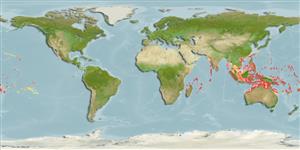>
Perciformes/Serranoidei (Groupers) >
Liopropomatidae (Painted basslets) > Diploprioninae
Etymology: Belonoperca: Greek, belone = needle; any fish with sharp pointed snout; also Pierre Belon, 1517-64, French zoologist born in Le Mans. Professor at the College de France, author of " La nature et diversité des poissons", 1551 + Greek, perke = perch (Ref. 45335).
Eponymy: Dr Paul Chabanaud (1876–1959) was a French ichthyologist and herpetologist. [...] (Ref. 128868), visit book page.
More on authors: Fowler & Bean.
Environment: milieu / climate zone / intervalo de profundidade / distribution range
Ecologia
marinhas associadas(os) a recifes; intervalo de profundidade 4 - 50 m (Ref. 9710). Tropical; 30°N - 23°S
Indo-Pacific: East Africa to Samoa, north to the Ryukyu Islands, south to New Caledonia.
Tamanho / Peso / Idade
Maturidade: Lm ? range ? - ? cm
Max length : 15.0 cm TL macho/indeterminado; (Ref. 9710)
Espinhos dorsais (total) : 9; Raios dorsais moles (total) : 10; Espinhos anais: 2; Raios anais moles: 8. Body brown in color (may also be dusky bluish grey to almost black (Ref. 48635)), caudal peduncle with saddle-like yellow spot; large ocellated black spot on spinous dorsal (Ref. 4326).
Body shape (shape guide): elongated; Cross section: compressed.
Occurs in steep slopes of coral rich areas. Usually hovers in mid water in caves (Ref. 9710). Nocturnal species (Ref. 4326). Secretive and solitary (Ref. 37816). Feeds on small fishes and crustaceans (Ref. 89972). Easily missed and normally the yellow spot is noticed first (Ref. 48635). Produces the skin toxin grammistin.
Life cycle and mating behavior
Maturidade | Reprodução | Desova | Ovos | Fecundidade | Larvas
Randall, J.E., G.R. Allen and R.C. Steene, 1990. Fishes of the Great Barrier Reef and Coral Sea. University of Hawaii Press, Honolulu, Hawaii. 506 p. (Ref. 2334)
Categoria na Lista Vermelha da IUCN (Ref. 130435: Version 2025-1)
Ameaça para o homem
Harmless
Utilização humana
Ferramentas
Relatórios especiais
Descarregue XML
Fontes da internet
Estimates based on models
Preferred temperature (Ref.
123201): 25.8 - 28.8, mean 27.6 °C (based on 426 cells).
Phylogenetic diversity index (Ref.
82804): PD
50 = 0.7500 [Uniqueness, from 0.5 = low to 2.0 = high].
Bayesian length-weight: a=0.00389 (0.00180 - 0.00842), b=3.12 (2.94 - 3.30), in cm total length, based on all LWR estimates for this body shape (Ref.
93245).
Nível Trófico (Ref.
69278): 4.0 ±0.67 se; based on food items.
Fishing Vulnerability (Ref.
59153): Low vulnerability (10 of 100).
🛈
Nutrients (Ref.
124155): Calcium = 84 [48, 177] mg/100g; Iron = 0.642 [0.326, 1.169] mg/100g; Protein = 18 [16, 20] %; Omega3 = 0.115 [0.065, 0.210] g/100g; Selenium = 29.4 [14.0, 62.4] μg/100g; VitaminA = 140 [42, 500] μg/100g; Zinc = 1.42 [0.90, 2.14] mg/100g (wet weight);
